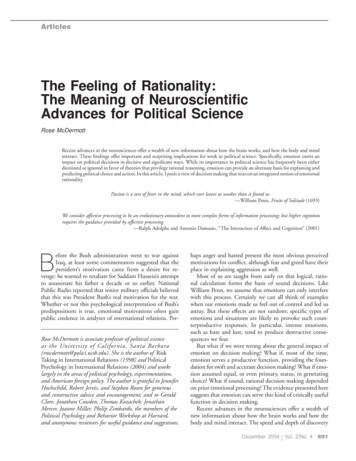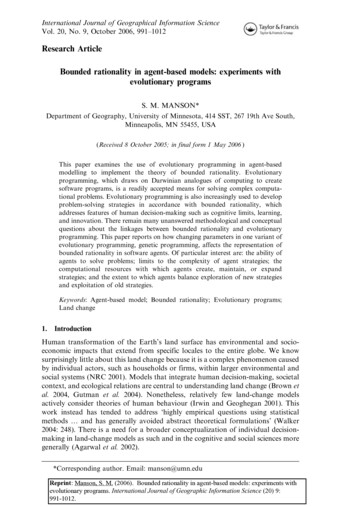
Transcription
ArticlesThe Feeling of Rationality:The Meaning of NeuroscientificAdvances for Political ScienceRose McDermottRecent advances in the neurosciences offer a wealth of new information about how the brain works, and how the body and mindinteract. These findings offer important and surprising implications for work in political science. Specifically, emotion exerts animpact on political decisions in decisive and significant ways. While its importance in political science has frequently been eitherdismissed or ignored in favor of theories that privilege rational reasoning, emotion can provide an alternate basis for explaining andpredicting political choice and action. In this article, I posit a view of decision making that rests on an integrated notion of emotionalrationality.Passion is a sort of fever in the mind, which ever leaves us weaker than it found us.—William Penn, Fruits of Solitude (1693)We consider affective processing to be an evolutionary antecedent to more complex forms of information processing; but higher cognitionrequires the guidance provided by affective processing.—Ralph Adolphs and Antonio Damasio, “The Interaction of Affect and Cognition” (2001)Before the Bush administration went to war againstIraq, at least some commentators suggested that thepresident’s motivation came from a desire for revenge: he wanted to retaliate for Saddam Hussein’s attemptto assassinate his father a decade or so earlier. NationalPublic Radio reported that senior military officials believedthat this was President Bush’s real motivation for the war.Whether or not this psychological interpretation of Bush’spredispositions is true, emotional motivations often gainpublic credence in analyses of international relations. Per-Rose McDermott is associate professor of political scienceat the University of California, Santa Barbara(rmcdermott@polsci.ucsb.edu). She is the author of RiskTaking in International Relations (1998) and PoliticalPsychology in International Relations (2004) and workslargely in the areas of political psychology, experimentation,and American foreign policy. The author is grateful to JenniferHochschild, Robert Jervis, and Stephen Rosen for generousand constructive advice and encouragement; and to GeraldClore, Jonathan Cowden, Thomas Kozachek, JonathanMercer, Joanne Miller, Philip Zimbardo, the members of thePolitical Psychology and Behavior Workshop at Harvard,and anonymous reviewers for useful guidance and suggestions.haps anger and hatred present the most obvious perceivedmotivations for conflict, although fear and greed have theirplace in explaining aggression as well.Most of us are taught from early on that logical, rational calculation forms the basis of sound decisions. LikeWilliam Penn, we assume that emotions can only interferewith this process. Certainly we can all think of exampleswhen our emotions made us feel out of control and led usastray. But these effects are not random; specific types ofemotions and situations are likely to provoke such counterproductive responses. In particular, intense emotions,such as hate and lust, tend to produce destructive consequences we fear.But what if we were wrong about the general impact ofemotion on decision making? What if, most of the time,emotion serves a productive function, providing the foundation for swift and accurate decision making? What if emotion assumed equal, or even primary, status, in generatingchoice? What if sound, rational decision making dependedon prior emotional processing? The evidence presented heresuggests that emotion can serve this kind of critically usefulfunction in decision making.Recent advances in the neurosciences offer a wealth ofnew information about how the brain works and how thebody and mind interact. The speed and depth of discoveryDecember 2004 Vol. 2/No. 4 691
Articles The Feeling of Rationalityin the neurosciences promise the unfolding of the first majortheoretical innovation in the social sciences of the twentyfirst century: the new neurological revolution is upon us.These findings offer important and surprising implicationsfor work in political science. Neuroscientific research canhelp answer a question that should be of central concern topolitical scientists: Under what conditions do emotions helpexplain decision making? By addressing this question, wecan also consider how emotion-based models might amplifyexisting models of decision making.After discussing several important theories of emotion, Ioutline ten ways in which emotion theory can enhance ourunderstanding of decision making. These are the basis for anew neuroscientifically informed, emotion-privileged framework for the analysis of decision making. This move towarda theory of emotional rationality is a first step in seeking toincorporate recent advances in the cognitive neurosciencesinto political science theory and practice. Finally, I considersome policy implications of an emotion-based theory ofdecision making.Definitional TermsThere is no consensual scholarly definition of emotion. AsJoseph LeDoux writes in his introduction to the topic ofemotion,Controversy abounds over the definition of emotion, the numberof emotions that exist, whether some emotions are more basicthan others, the commonality of certain emotional response patterns across cultures and across species, whether different emotions have different physiological signatures, the extent to whichemotional responses contribute to emotional experiences, the roleof nature and nurture in emotion, the influence of emotion oncognitive processes, the dependence of emotion on cognition, theimportance of conscience versus unconscious processes in emotion, and on and on.1LeDoux concludes by calling for a more brain-based, neurological understanding of emotion. For my purposes, I willrely on Gerald Clore and Andrew Ortony’s definition: “emotion is one of a large set of differentiated biologically basedcomplex conditions that are about something. Emotions inhumans are normally characterized by the presence of fourmajor components: a cognitive component, a motivationalbehavioral component, a somatic component, and asubjective-experiential component.” 2 Emotion thus encompasses thoughts, motivations, bodily sensations, and an internal sense of experience. However, this definition requiresfurther refinement in order to differentiate emotion fromaffect, mood, and feeling, which, though often used synonymously, refer to different phenomena.Affect refers to the way people represent the value ofthings as good or bad; it can include preferences as well asemotions and moods. Moods are amorphous states—likeemotions, but without specific objects or referents. Finally,feelings are the actual experience of value. Clore argues thatfeelings represent feedback from internal states that provide692 Perspectives on Politicsconscious information from nonconscious physical, cognitive, or other processes.3Whether emotions are conscious or unconscious has notbeen settled, though the question has been present in psychology since its origins, when William James posed hisfamous question about running from the bear out of fear,or experiencing fear as a result of running from the bear.4Another issue in the ongoing discussion about emotion hasto do with the extent to which emotion is a cognitive process. In his original conception of the trilogy of mind, ErnestHilgard asserted that the mind is made up of cognition,emotion, and motivational processes—therefore supposingthat emotion and cognition represent fundamentally different processes.5 Robert Zajonc initiated the reemergence ofthe debate over the place of emotion in cognition, callingfor a reincorporation of affect into psychology and arguingthat cognition and affect were at least partly independentsystems and that the latter could precede the former underat least some conditions.6 Recent evidence by Clore andcolleagues suggests that these structures may be more intertwined than previously realized, with the brain nonethelessprivileging emotional centers of information processing.7In some ways, how much cognition is in emotion remains adefinitional chicken-and-egg problem:The issue of whether emotional processing is dependent on priorcognitive processing is reduced to a question of how we definecognition. If cognition is defined broadly to include sensory information processing . . . then emotional processing . . . is highlydependent on cognitive processing. If cognitive processing is definednarrowly to include only the higher mental functions . . . thenemotion is not necessarily dependent on prior cognitive processing.8In short, while some argue that emotion is cognitionbecause it involves appraisal,9 Zajonc and others argue thatthis is not so because cognitive processing represents onlyone type of information processing.10 Many of our biological processes (heartbeat, immune system, et cetera) are regulated by unconscious information-processing systems; justbecause a function requires information processing, like emotion, it need not be cognitive in nature. More recent researchstrives to integrate theories of cognition and emotion. Thismatters for political scientists because our analytical perspectives should reflect the fact that emotion is as essentialas reason to the decision-making process; one cannot existwithout the other.As noted above, emotion has a physiological foundation.Stimuli from the external world induce physiological changeswithin the human body. For instance, a fearful situationmay provoke production of adrenalin, which induces theclassic fight-or-flight response—at least in men.11 The physiological basis of emotion helps explain several aspects ofthe interconnecting nature of emotion and cognition indecision making. The limbic system, which humans sharewith other mammals, is hardwired to subserve emotion tomaximize chances for survival. This part of the brain regulates basic biological mechanisms like body temperature,
hunger, thirst, sleep, sexual drive, and so on. This area iswhere the primary emotional centers are located and includesthe thalamus, which receives incoming information fromthe outside world through the sensory organs, and the amygdala. The amygdala comes in two parts, one on each side ofthe brain, and is about the size of a walnut. Recent researchincreasingly suggests that the amygdala serves as the lodestonefor emotion, especially fear, and as a filter for memory.Overall, the limbic system allows for processing of information, even before or instead of passing it along to the cortex,the neural basis for higher-level social and cognitive functioning. The more advanced part of the brain, located mostlyin the prefrontal cortex, develops from birth in interactionwith the environment and grows largely in reaction to learning from the outside world. That is why people differ fromculture to culture, but they share certain basic human processes. For example, all people use language to communicate, but they do not all use the same language.The brain’s primary purpose is to ensure the organism’ssurvival. Information coming from the external world isfirst processed through the limbic system, which decideswhether the information indicates a challenge to survival.The amygdala has a long neural connection to the thalamusand constantly scans incoming information for signs of anemotional emergency. If there is none, the amygdala recognizes that there is time for more advanced processing throughthe prefrontal cortex, which is responsible for more abstract,rational thought. But if the brain decides that the information indicates a threat, it shuts down the higher mentalprocesses through the release of catecholamine neurotransmitters, which also turn on the action of the emotionalbrain to react quickly and efficiently to threats. This processing hierarchy evolved to help humans survive fight-orflight kinds of challenges. (You need to hit the brake inyour car to avoid hitting the child in front of you beforeyou think about who the child is, what you need to do tostop the car, and so on.)Thus the brain’s structural makeup requires that emotional information exert an influence before, and sometimes instead of, higher-level cognitive functioning. Thismeans that rationality, as we understand it, often requiresemotional processing first. At least it requires that emotional processing takes place as an integral part of rationalcognitive processing. This finding alone begins to undermine theories of rationality that presume that emotion iseither not involved in decision making or exists in opposition to the highest-quality decision making. Political scientists, in particular, have generally assumed, contrary toscience, that rational processing takes place independentlyof emotional processing and that the latter only interfereswith the proper functioning of the former.To be clear, my argument is not simply that emotionhelps form preferences—although it does—and then rational logic takes over. Rather, I suggest that emotion is part ofrationality itself, and that the two are intimately inter-twined and interconnected processes, psychologically andneurologically. From this perspective, emotion remainsendogenous to rationality itself.Theories of EmotionVarious modern theories have arisen to explain the natureof emotion. Five deserve mention here because of their implications for emotion-based decision making.First, Robert Zajonc has argued that people can havestrong preferences without any prior or simultaneous cognitive inferences.12 Using subliminal cues, Zajonc showedthat people like things due to mere exposure effects. Heflashed some unfamiliar objects very quickly across a screen,much faster than a subject could consciously see or recognize. In subsequent judgments, the subjects later claimed toprefer those objects that had been subliminally displayedover other objects which had not.Second, Barbara Mellers and colleagues argue, in adecision-affect theory, that emotional reactions are not simply the result of the utility and probability of the outcome,as rational theories might suggest.13 Rather, unexpected outcomes also exert an impact on emotional reaction; surprisescan feel more pleasant (if positive) or more painful (if negative) than expected outcomes. To take another example,even good outcomes seem less pleasant if an unrealized outcome seems better; a 1,000 raise can enrage a person whohad been promised a much larger salary increase. Risk propensity can be understood to result from an attempt tomaximize expected emotional reactions.14 Decision-affecttheory thus combines the notions of utilities, expectations,and counterfactuals into a theory of emotional reaction.Antonio Damasio and his colleagues have conducted someof most sophisticated recent neuroscientific work in thisarea, and their data have led to another theoretical orientation. They have accumulated one of the most comprehensive inventories in the world of patients with particular kindsof brain damage. Evidence from these patients enables Damasio to argue convincingly for the primacy of emotion indecision making.15Consider “Elliot,” a patient who sought diagnosis in aneffort to obtain disability benefits.16 He was an obviouslyintelligent man who was no longer able to hold a job orkeep his marriage together in the wake of surgery for abrain tumor, although he did not score outside normal limits on any standard neurological or intelligence tests. Ostensibly the surgery had worked. Yet Damasio characterizesElliot as a modern-day Phineas Gage—the famous railwayworker who had a tamping iron propelled through his skullby an explosion and lived through the accident only toregress subsequently in all aspects of his personal and sociallife. Elliot had been a happily married man with two youngchildren and a good job at the time that his tumor wasdiscovered and surgically removed. Despite no clear neurological damage after surgery, Elliot’s marriage subsequentlyDecember 2004 Vol. 2/No. 4 693
Articles The Feeling of Rationalityfailed, he lost his job, and he was fired from several others.Damasio determined that Elliot suffered damage to his ventromedial prefrontal cortex—the same place that Gage hadsustained damage 17 —which left him unable to properlynegotiate his personal and social world despite an intactintelligence. Damasio argues that this ventromedial sectionof the brain remains critical to emotional processing, andwithout it, decision making suffers, too. For example, Elliottakes half an hour to choose one of two dates for making hisnext appointment, using sophisticated “rational” strategiesinvolving cost-benefit calculations. While this process mightbe optimal in making difficult and important life decisions,it is not effective for everyday tasks.Damasio argues that these recent neuroscientific discoveries of how the brain processes emotional information demonstrate that reason and rationality are not the distinctfunctions we have traditionally believed them to be, but arerather processes that involve emotion and feelings in a central way.18 Without the ability to reference emotion, peopleremain incapable of making so-called “rational” decisions,especially in the social realm. Damasio and his colleagues demonstrated this process with a series of ingenious experimentsconducted with subjects who had preexisting brain lesions inthe ventromedial cortex.19 These people appear normal, dowell on intelligence and memory tests, and usually have noimpairments in attention, memory, or language skills. Theydemonstrate little emotion, however, and though they haveaccess to appropriate social information, which they can applyto relevant situations, they repeatedly make very bad socialreal-life decisions. This appears to result from their inabilityto envision future consequences. They cannot delay shortterm gratification for the purpose of long term gain.20In their experiment, Damasio and his fellow researcherspresented subjects with 2,000 and four decks of playingcards. Each card had an amount of money that the playerwins or loses printed on its face.21 Subjects received two“bad” decks of cards, which gave subjects many early largerewards of 100 but later took large sums away. The two“good” decks paid lower rewards, about 50 on average,but also took less money away. In the long run, subjectscould earn money with the good decks, and would losemoney on the bad ones. Subjects with damaged ventromedial sectors never learned to distinguish between the goodand bad decks, and continued to lose money by preferringthe decks with high payoffs and high losses. Unimpairedsubjects quickly learned to pick from the good decks. Evenmore interestingly, such subjects learned to make correctdecisions long before they could say why they were doingso. Although none of the unimpaired subjects reported consciously calculating the outcome in the midst of the game,the good decks “felt right” to them after a few trials. Skinconductance tests demonstrated that the unimpaired subjects received physiological feedback as they played, whilethe subjects with brain lesions did not experience muchstress or nervousness.694 Perspectives on PoliticsAntoine Bechara and his colleagues conclude from theseobservations that the impaired subjects lacked the bodilysignals that stimulate formation of appropriate emotionalmemories and that their neurological deficit completely prevented them from bypassing the drive for immediate gratification.22 The emotional references quickly available tounimpaired subjects never became available to the impairedpatients, whose emotion-processing centers in the limbicsystem were not properly connected with their decisionmaking centers in the cortex. In real life many of the impairedpatients were badly socialized and suffered from problemsof cognitive-impulse control—multiple unwanted pregnancies, drug addiction, and gambling problems—whose appearance coincided with the timing of the various brain injuries.Gretchen Vogel provides the key inference here: “[E]motion apparently is not something that necessarily cloudsreasoning, but rather seems to provide an essential foundation for at least some kind of reasoning.” 23Damasio generalizes these experimental results into asomatic marker hypothesis.24 He posits that informationreceived through physical senses creates emotions, whichthen serve as the basis for our future decisions by providinga sense of what is good and bad, and what causes pleasureor pain, on the basis of prior learning and experiences. Aschildren grow and develop, certain bodily sensations relatedto reward and punishment become tied to particular events,people, and circumstances. Later in life, similar contextselicit the familiar bodily sensations that warn a person thatreward or punishment is likely to follow. Obviously, thislearning history can be perverted when a child developsinappropriate connections between events and outcomes.By and large, though, these emotional connections serveindividuals well later in life in determining quickly, efficiently, and nonverbally which people and events are likelyto lead to good outcomes and should be approached, andwhich should be avoided. These learned emotional responsesare continually updated with new information, at least inhealthy individuals.This network of associations allows the brain to use emotions to provide efficient and accurate information about awide variety of phenomena that help us make decisions.The brain’s processing capacity is far greater than what existsin our consciousness, and emotions allow us to decide whatto pay attention to in the world around us. The brain,because of an evolutionary development that stressed survival, privileges, in speed and impact, emotional information over cognitive processing in the first stages of decisionmaking. As Damasio writes, “I see feelings as having a trulyprivileged status. They are represented at many neural levels. . . . [B]ecause of their inextricable ties to the body, theycome in first in development and retain a primacy thatsubtly pervades our mental life.” 25The fourth emotion theory relevant to the present discussion is the affect-as-information model developed by Gerald Clore and his colleagues.26 This model suggests that
emotion exists to provide feedback to the person aboutunconscious processes.27 The information is then conveyedto others through facial expressions and vocal intonations,and to ourselves through thoughts and feelings. Judgmentscan thus prove susceptible to persuasion and manipulationbecause they can be unduly influenced by unrelated emotional forces.28 For example, voters’ responses to particularcandidates can be affected if they are emotionally moved bysymbolic features associated with a campaign, such as flagwaving, patriotic music, or the happy facial expression ofan attractive candidate. From this perspective, feelings represent appraisals.Finally, George Marcus, W. Russell Neuman, and MichaelMacKuen developed a model of political involvement thatrests on Jeffrey Gray’s neural-behavioral theories.29 Graybelieves that the limbic system is divided into differentsystems that relate to reward and punishment.30 Reward iscontrolled by the behavioral approach system (BAS) andpunishment by the behavioral inhibition system (BIS).The BAS produces emotions along a continuum of happyto sad values, while the BIS focuses on threat and novelty.The BIS is responsible for learning, because novelty orthreat elicits attention. Marcus, Neuman, and MacKuenpredict that anxiety reduces voters’ reliance on habits suchas party identification and increases attention to new information, such as a candidate’s issue positions. They findthat political learning is enhanced by increased voter anxiety, while political engagement is fostered by enthusiasm,a function of the BAS.Emotion in Decision MakingBeyond the general literature on the relationship betweenemotion and cognition, several areas of research into theimpact of emotion on decision making appear directly relevant to political science. Indeed, some of this work hasbeen conducted within political science, including study ofthe impact of facial expressions on voting,31 affective judgment and political behavior,32 and the relationship betweenemotion and democratic processes.33 Related work in psychology and political psychology has focused on four areasof research at the intersection of emotion, cognition, anddecision making.34 These include emotion during decisionmaking, emotions after decision making, anticipated emotions, and memories of past emotions.Emotions during decision makingGeorge Loewenstein and Jennifer Lerner provide a comprehensive and concise summary of the mechanisms by whichaffect influences decision making during the process itself.35They note the limitations of the consequentialist notion ofjudgment and decision making, which ignores the impactof emotions—even gut feelings 36 —or implies that emotioncan only lead decision makers astray. They emphasize insteadthe importance of expected emotions, or predicting the emo-tional consequences of a given decision. However, peopleare notoriously bad at predicting their emotional reactionsin the future. They respond more to change than to absolute values in assessing the consequences of their decisions.In addition, people tend to compare real outcomes to counterfactual ones and to evaluate utility not only on the basisof real outcome, but also on the basis of what those outcomes say about their own competence relative to others.Objectively good outcomes that make one look bad are notnecessarily experienced in a positive light. For example, nominees for high-level government positions often report feeling humiliated by the Senate confirmation process, even ifthey are eventually confirmed. In addition, people tend todiscount outcomes that are uncertain or temporally delayed.Immediate emotions are experienced at the time of the decision itself.The effects can be direct—the intensity of the emotion itself in the moment—or indirect, through their impacton the expected value, quality, and depth of information processing. Incidental or anticipatory processes—like anxietyabout the future—can partially determine immediate emotions. Anticipatory feelings appear insensitive to probability,but very sensitive to timing and vividness; moreover, theydepend on the individual’s sense of control over his or herenvironment. Incidental influences on immediate emotionsinclude both state (situational) and trait (enduring characterological) factors, which may be irrelevant to the decisionat hand but can nonetheless influence decision making byfostering generalized bad or good feelings.37Gordon Bower, among others, has established importantlinks between mood and memory that are pertinent to decision making.38 The theory of mood congruence states thatindividuals are more likely to remember events that are consistent with their present mood. In other words, people selectively take in information consonant with their current moodstate.39 Mood-dependent retrieval, on the other hand, examines the way in which people’s current mood affects their recallof past events.40 For example, depressed people demonstratea strong bias toward only recalling negative events from theirpast.41 The effects appear strongest in the realm of autobiographical memory. Explanations for this phenomenon typically rely on a network association hypothesis, suggestingthat people associate emotion with the events or thoughtsthat take place at the same time. Later research indicated thatfor such a memory association to take place, the person mustcausally attribute the temporally relevant events to the emotional arousal.42 These effects reliably take place in a widevariety of domains, including individuals’ recall and evaluation of prospects for the future, the likelihood of bad or goodthings happening in the future, accepting positive and negative feedback about their personality, explaining successesand failures, and estimating personal skills.I believe that the use of historical analogies in decisionmaking conforms to models of mood-congruence. For example, an anxious leader may be sensitive to the emotionalcontent of an enemy’s hostile rhetoric, ultimatums, andDecember 2004 Vol. 2/No. 4 695
Articles The Feeling of Rationalitygraphic pictures of military build-ups than to objective probabilities about the actual likelihood of threat or attack. Further, a general mood of fear or anger, triggered by vividimages or rhetoric, can influence decision making. Theleader’s mood may then affect which lessons from historyare drawn on—events that generated similar emotions ofanger or fear in the past become more accessible. Learningfrom history can thus be driven by affect as well as by rational thought about probabilities or utility assessments.Mood influences information processing-strategies as well.Happy people tend to be expansive in their judgments anddecisions, using preexisting theories in a top-down manner.Unhappy people, however, tend to focus on details andprefer bottom-up decision-making strategies.43 In otherwords, optimism can lead to creative decision making,44while pessimism and anger may lead to the opposite.45 Furthermore, when people are happy, they overestimate thelikelihood of positive outcomes, and when they are sad,they overestimate the probability of negative outcomes. Thispropensity can bias which options are considered in theface of crisis.46Some intriguing experimental work suggests that gameplayers are affected by mood. Happy players mimic thestrategy of their opponent, while sad players make theirmoves on the basis of detached analysis of the game itself.47Happy players are thus more socially engaged and interactive than sad players. This finding appears relevant toJames David Barber’s characterization of presidential leadership type along dimensions of positive and negative aswell as active and passive.48 By extension, l
Rose McDermott Recent advances in the neurosciences offer a wealth of new information about how the brain works, and how the body and mind interact. These findings offer important and surprising implications for work in political science. Specifically, emotion exerts an impact on political decisions in decisive and significant ways.










